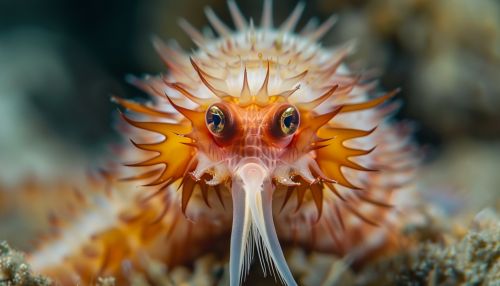Acanthocephalans
Introduction
Acanthocephalans, also known as thorny-headed worms, are a phylum of parasitic worms known scientifically as Acanthocephala. These organisms are characterized by their spiny proboscis, which they use to anchor themselves to the intestinal walls of their hosts. Acanthocephalans are obligate parasites, meaning they must live part of their life cycle within a host organism. They primarily infect vertebrates, including fish, birds, and mammals.
Taxonomy and Classification
Acanthocephalans belong to the phylum Acanthocephala, which is divided into four classes: Archiacanthocephala, Eoacanthocephala, Palaeacanthocephala, and Polyacanthocephala. These classes are further divided into orders, families, genera, and species. The classification is based on morphological characteristics, such as the structure of the proboscis, hooks, and reproductive organs.
Morphology
Acanthocephalans exhibit a unique morphology that distinguishes them from other parasitic worms. The most notable feature is the proboscis, a retractable, spiny organ used for attachment to the host's intestinal wall. The body is divided into three main regions: the proboscis, the neck, and the trunk. The trunk contains the reproductive organs and is often covered with tegument, a specialized outer layer that protects the worm from the host's digestive enzymes.


Life Cycle
The life cycle of acanthocephalans is complex and involves multiple hosts. Typically, the life cycle includes an intermediate host, usually an arthropod, and a definitive host, which is a vertebrate. The cycle begins when the intermediate host ingests the eggs, which hatch into larvae called acanthors. These larvae develop into cystacanths within the intermediate host. When the definitive host consumes the infected intermediate host, the cystacanths develop into adult worms in the intestines of the definitive host.
Host-Parasite Interactions
Acanthocephalans have evolved various mechanisms to evade the immune responses of their hosts. The tegument plays a crucial role in protecting the parasite from the host's digestive enzymes and immune cells. Additionally, some acanthocephalans can manipulate the behavior of their intermediate hosts to increase the likelihood of transmission to the definitive host. For example, infected arthropods may exhibit altered behavior that makes them more susceptible to predation by vertebrates.
Pathology and Impact on Hosts
The presence of acanthocephalans in the host's intestines can lead to various pathological conditions. The attachment of the proboscis can cause physical damage to the intestinal wall, leading to inflammation, ulceration, and secondary infections. In severe cases, heavy infestations can cause intestinal blockage, malnutrition, and even death. The impact on the host varies depending on the species of acanthocephalan and the host's overall health.
Diagnosis and Treatment
Diagnosis of acanthocephalan infections typically involves the identification of eggs or adult worms in the host's feces or intestinal contents. Microscopic examination and molecular techniques, such as PCR, are commonly used for accurate identification. Treatment usually involves the administration of anthelmintic drugs, which are designed to kill parasitic worms. Preventative measures, such as controlling intermediate host populations and maintaining good hygiene, are also important in managing acanthocephalan infections.
Ecological and Evolutionary Significance
Acanthocephalans play a significant role in the ecology of their host species. By influencing the behavior and health of their hosts, they can affect predator-prey dynamics and the overall structure of ecosystems. From an evolutionary perspective, acanthocephalans provide valuable insights into host-parasite coevolution and the adaptation of parasites to their hosts.
Research and Future Directions
Current research on acanthocephalans focuses on understanding their complex life cycles, host-parasite interactions, and the molecular mechanisms underlying their parasitism. Advances in genomics and proteomics are providing new tools for studying these parasites at the molecular level. Future research aims to develop more effective diagnostic methods, treatments, and preventative measures to control acanthocephalan infections.
